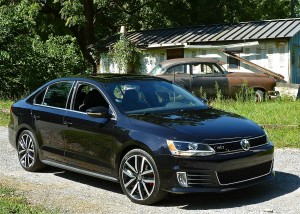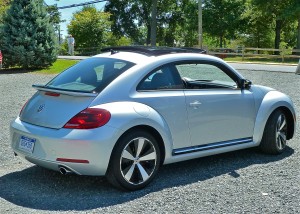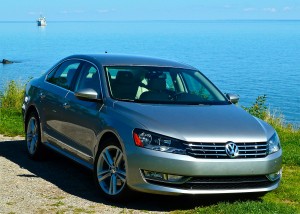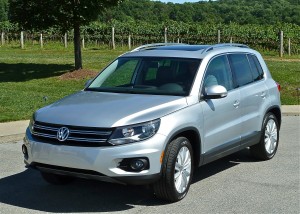Revised 2012 VWs expand models, power
By John Gilbert
Have you ever experienced an earthquake? In late August, I was right up close and personal with the epicenter of the 5.8-level earthquake that struck in Virginia, and caused tremors all the up the East Coast to Washington, D.C., New York City, and up to New Hampshire.
When I mentioned that to a fellow back in Minnesota, he was horrified and said how lucky I was to have lived through it. Then I had to explain that I actually didn’t feel a thing. I was shielded from any awareness of the upheaval by the refinements of a 2012 Volkswagen Jetta GLI. We tend to remember all the details of where we were when such important events happen at the same time, and at the same time, it seems as though you might have been cheated out of a memorable experience if you can’t regale friends with details about the earth tilting, lamps swaying, trees falling down, etc.
But there I was, driving a Jetta GLI on a rural highway in a rural part of the state of Virginia. The car is new for 2012, with upgraded suspension, appearance items, interior features, and engine power. It responded perfectly to all my inputs of acceleration, shifting, sweeping around tight curves, and stopping with precision. When I returned from the test loop to the Breaux Winery, where the full collection of 2012 VW vehicles had been gathered, someone breathlessly asked: “Did you feel it?â€
“Feel what?†I responded. I’m not one to seek out natural disasters, but I’m also not about to pass up witnessing one if it happens and I can be a safe distance away. This earthquake epicenter was Richmond, Va., less than 50 miles away from where we were. People at the winery felt the earth move, and I later saw video of offices and apartments where things fell off shelves and bookcases tipped over. I suggested to a Volkswagen PR type that his staff might have capitalized by saying it wasn’t an earthquake, just the ground shaking from all the torque produced by the VW fleet of turbo-diesels. Or, as in my case, I could visualize a commercial where the earth is opening into gaping crevasses, and buildings are toppling, but someone in a Jetta GLI (or Passat, CC, or Routan, Tiguan, Golf, Beetle, or Touareg) cruises blissfully past, listening to the new Fender-by-Panasonic audio surround system and feeling nothing because of the slick suspension and improved silence of VW’s modern interior noise reduction.
Volkswagen, however, is more pragmatic than that. Jonathan Browning, president and CEO of Volkswagen Group of America, explained that VW had lost market share in the U.S. from the 1990s, and has aggressive plans to recapture that, and more. Much more. VW wants to become the largest automaker in the world, and, judging by the strength of its full line, it has a realistic chance to achieve that in the not too distant future.
“As we go forward, we have a very clear vision where we want to go,†said Browning. “We want to be leading in quality, we want to be the top employer, we want to improve to 8 percent market share, and we want to be first in customer satisfaction.â€
There are several keys to VW’s optimism for 2012. First is its deep commitment to U.S. sales, having just opened a new plant in Chattanooga, Tenn., where the new Passat is being built. Restructuring the full line should help, too. The Jetta and Passat both drop directly into the compact and midsize categories. The Jetta is a strong alternative to the Civic, Corolla, Focus, Mazda3, Sentra mainstays, and moves up smartly with the added GLI. The Passat, with its superior room and features, becomes a worthy candidate for Accord-Camry-Altima-Malibu-Fusion-Sonata buyers.
Redesigning the Beetle by lowering its roof and changing the classic shape from a symmetric bubble to more of a sportier stance, should give it new life, as well. Similarly, the Golf remains a solid hatchback subcompact, and while it still has the potent GTI model for strong performance, it also adds the Golf R, which will run away and hide from a GTI.
The most impressive thing about the VW fleet is under the hood. I’m not a big fan of the 2.5-liter 5-cylinder engine, but it is strong and smooth and develops a lot of torque. I am a fan of the 2.0-liter 4-cylinder — particularly the Audi-sourced 2.0 with direct-injection and turbocharging — which can be tuned for normal running from sporty performance to all-out power, with the only drawback being the need for premium fuel to run its best.
And I am overwhelmed by VW’s 2.0-liter TDI — the VW developed turbo-diesel that combines impressive torque with fantastic fuel mileage figures, and is available in many VW models from top to bottom. The larger 3.6-liter VR6 has been refined to produce maximum power and it has proved to also provide surprisingly good fuel economy. At the top of the list is the 3.0-liter V6 TDI, another Audi turbo-diesel, which can be obtained in the Touareg, VW’s larger and hardier SUV.
At the introduction, we got a chance to do sample test drives of everything in the Volkswagen arsenal, including new specialty entries such as the Golf R, while the Jetta GLI gives GTI sting to the more docile Jetta sedan.
Some of the returnees are equally as impressive, of course, but the most impressive thing is that you have to be very surprised to see just how many different models VW has, with which to cover every niche:
- Beetle — The redesign is subtle, until you park the 2012 alongside a 2011 “New Beetle,†or alongside an original 1949 model. Moving the “A†pillar — just ahead of the doors — back a bit allowed the roofline to be lowered with no appreciable loss in the vast headroom. now wider and more spacious, the Beetle starts with the 2.5-liter 5-cylinder with 170 horsepower and a 5-speed manual or 6-speed automatic at $18,995; the 2.0 Turbo has 200 horsepower and 207 foot-pounds of torque and either a 6-speed stick or 6-speed DSG clutchless-manual automatic, starting at $23,395. A new and impressive Fender audio system by Panasonic is available.
- Golf — Available either as 2- or 4-door hatchbacks, base engine is 2.5-liter 5-cylinder with 170 horses and 177 foot-pounds of torque, rated at 33 mpg highway. Base price is $17,995. The prize, however, is the TDI clean diesel, a 2.0-liter workhorse that gets an EPA estimated 42 mpg highway, with either stick or the DSG (direct sequential manual) automatic. The TDI, with a base price of $23,995, has only 140 horsepower, but 236 foot-pounds of torque launches the Golf TDI with GTI-like force up to 50. Reports of Golf TDI owners getting over 50 mpg at steady-state cruising are numerous. The Golf’s sixth generation debuted for 2011, and sales improved 23.3 percent, year-to-date.
- GTI — VW likes to break the sporty Golf away from Golf livery, and as a stand-alone model it starts at $23,695 with firmer suspension and the 2.0 turbo gas engine with 200 horses and 207 torque reading. First appearing in the U.S. as a Rabbit GTI in 1983, after launching in 1976 in Europe, the GTI is the original pocket rocket, and now comes with 6-speed stick or 6-speed DSG automatic.
- Golf R — It had to happen. VW has out-GTI’d the GTI with the R, which tweaks the 2.0-liter TSI turbo gas engine to 256 horsepower and 243 foot-pounds of torque, which occur at that peak from 2,400-5,200 RPMs. VW sold an R32 model previously, using the VR6 engine, but the 2.0-Turbo’s power and 4Motion all-wheel-drive make the R the best road-holding and sportiest Golf model ever sold. A 6-speed manual is standard. The Golf R comes in either 2- or 4-door hatchback models.
- Jetta — Completely redone for its sixth generation a year ago, the Jetta has absorbed some car-magazine criticism for being a bit less substantial than its predecessor. But VW’s purpose was to scale down its base price, which it did — to $16,495. And consumers ignored the car-buff publications and have bought Jettas at a rate that is 74.8 percent higher than in 2010. Base engine is a quite stodgy 2.0-liter gas engine, or the same 2.5 as the Golf uses for a base engine. Again, the 2.0 TDI turbo-diesel gives the Jetta some low-end punch with EPA estimates of 42 mpg. New to the Jetta range for 2012 is the return of the GLI, which has the turbo 2.0 gas engine with 200 horsepower, sport-tuned multi-link supsension, and either the 6- speed stick or DSG automatic, and 33 mpg EPA highway estimates. The GLI base price is $23,495.
- Jetta SportWagen — The SportWagen is separated from the new restyled Jetta for a very good reason — it is based on the European Golfwagon, which was new in 2010, and it remains sleek and sporty to look at and to drive. Under the hatch is 32.8 cubic feet of cargo volume, which expands to 66.9 with the rear seats foldd down. The 2.5-liter 4 is the base engine, but the optional turbo-diesel not only is a significant upgrade, it accounts for 80 percent of all SportWagens sold in the U.S. The 2.0 TDI makes the vehicle the only clean diesel wagon available in the U.S. The base SportWagen starts at $19,995, while the TDI starts at $25,260.
- Eos — Named after the Greek goddess of dawn, the Eos has a revised front end, similar to the Golf and Jetta, and the car transforms from a sleek 2-door coupe to a convertible when the five-section hardtop folds itself up and stashed itself under a panel above the trunk. The only engine is the 2.0-liter Turbo gas engine, and the only transmission is the 6-speed DSG sequential automatic. Base price is $33,995.
- Passat — All-new, built in the U.S. at Chattanooga, the Passat is more than a large Jetta. It has excellent room in the front, enormous room in the back, and a huge trunk, all of which are large
assets to compete against midsize stalwarts such as Accord, Camry, Malibu, Fusion, Altima, and Sonata. With a base price of $19,995, the Passat has the 170-horse 2.5-liter 5-cylinder, or the 140-horse (and 236 foot-pound) 2.0 TDI, and the 280-horse 3.6-liter VR6. The TDI has EPA highway estimates of 43 mpg, but has easily outdone that. One observer drove a Passat TDI from Seattle to San Francisco — 812.8 miles — one one tankful of fuel. I got over 40 mpg with a TDI, and surprised myself by getting 32 mpg with the powerful gas VR6.
- CC — The most stylish of all Volkswagens, the CC sedan has not been redesigned onto the new Passat platform, but continues to be built off the previous Passat, which is still made and sold in Europe. What started as a design that copied the Mercedes CLS “four-door coupe,†the CC takes over that role by standing pat while the CLS has been redesigned. A base price of $28,515 brings the 2.0-Turbo engine with 6-speed transmissions, either stick or DSG. Available is the VR6 engine with 280 horsepower and 265 foot-pounds of torque, which runs the 4Motion all-wheel-drive system.
- Routan — An odd duck that fits into the VW row, this is a reworked Chrysler minivan, and the 3.6-liter V6 is not VW’s VR6 but the new Chrysler Pentastar dual-overhead-cam 3.6, with 283 horsepower. It has a 6-speed automatic, and is rated at 25 mpg highway, seating seven, and adding keyless access and push-button start on some models. Base price is $27,020. The Routan drives smoothly and has all the features that have made the Grand Caravan and Town & Country a standard of minivans world wide.
- Tiguan — VW’s popular compact SUV has been redone with a new grille, headlights and taillights, and interior improvements include a standard trip computer, while exterior changes add 19-inch wheels and LED running lights. The 2.0-liter Turbo gas engine is the only powerplant, gaining 2 mpg to 27 on the highway, because of the addition of a 6-speed automatic. Base price of $22,840 helps sales increase by 32.6 percent over last year, and the solid Tiguan comes in either front-wheel drive or 4Motion all-wheel drive.
- Touareg — Volkswagen collaborated with Audi and built the platform that serves as both the Porsche Cayenne and the VW Touareg. Refined through the years, the Touareg now has a choice of three engines — a 3.6 V6 with 280 horsepower, a 3.0-liter V6 TDI turbo-diesel with 225 horsepower, and a 380-horsepower supercharged hybrid model. All Touaregs use an 8-speed automatic transmission, and the TDI registers 28 mpg in highway estimates. The strong and burly SUV has a base price of $42,975 with the TDI model base at $46,475.
Volkswagen officials stressed that previous quality issues have been overcome amid the sweep of streamlining the full line and compacting prices to lower regions. The three stress-points are the quality and value of German engineering, styling and performance with timeless design, and the responsible commitment to the U.S. marketplace, as exhibited by the new Chattanooga facility.
Accompanying the 2012 model unveiling will be the continued cleverness of Volkswagen’s ad campaign, including the brilliant one of the youngster in the Darth Vader costume, pretending to be able to make magic happen with a gesture. His dad drives home in the family VW, and after going inside, he sees the kid outside trying to work his magic on the vehicle. The dad clicks the remote, causing the lights to blink in perfect timing to the kid’s gesture, which causes him to back off, startled at his own magic touch.
Another shows a party, where the birthday boy is unable to break a pinata with a stick, because it’s designed in the shape of a rugged VW. The group finally departs, and the dad stays behind, picking up the stick and smashing away at the pinata, but also unable to break it. Yet another shows a dad telling his son he can drive once they stop for fuel, but for now he should study his Spanish lesson. Since they have a TDI, they drive well into the night, because they can go 795 miles (or more) on a tankful. The kid, meanwhile, has so much time he learns to speak Spanish before they stop.
Overall, it is one of the more clever car ad campaigns in recent memory, which is fitting for a fleet of cars that give Volkswagen a full and complete array of vehicles, even if VW is missing the chance for one more ad idea. Not only are the cars solid, economical, roomy, and fun to drive, but they’re a great place to be if you want to drive along blissfully unaware of the earthquake going on outside.
Comments
Tell me what you're thinking...
and oh, if you want a pic to show with your comment, go get a gravatar!







 John Gilbert is a lifetime Minnesotan and career journalist, specializing in cars and sports during and since spending 30 years at the Minneapolis Tribune, now the Star Tribune. More recently, he has continued translating the high-tech world of autos and sharing his passionate insights as a freelance writer/photographer/broadcaster. A member of the prestigious North American Car and Truck of the Year jury since 1993. John can be heard Monday-Friday from 9-11am on 610 KDAL(www.kdal610.com) on the "John Gilbert Show," and writes a column in the Duluth Reader.
John Gilbert is a lifetime Minnesotan and career journalist, specializing in cars and sports during and since spending 30 years at the Minneapolis Tribune, now the Star Tribune. More recently, he has continued translating the high-tech world of autos and sharing his passionate insights as a freelance writer/photographer/broadcaster. A member of the prestigious North American Car and Truck of the Year jury since 1993. John can be heard Monday-Friday from 9-11am on 610 KDAL(www.kdal610.com) on the "John Gilbert Show," and writes a column in the Duluth Reader.